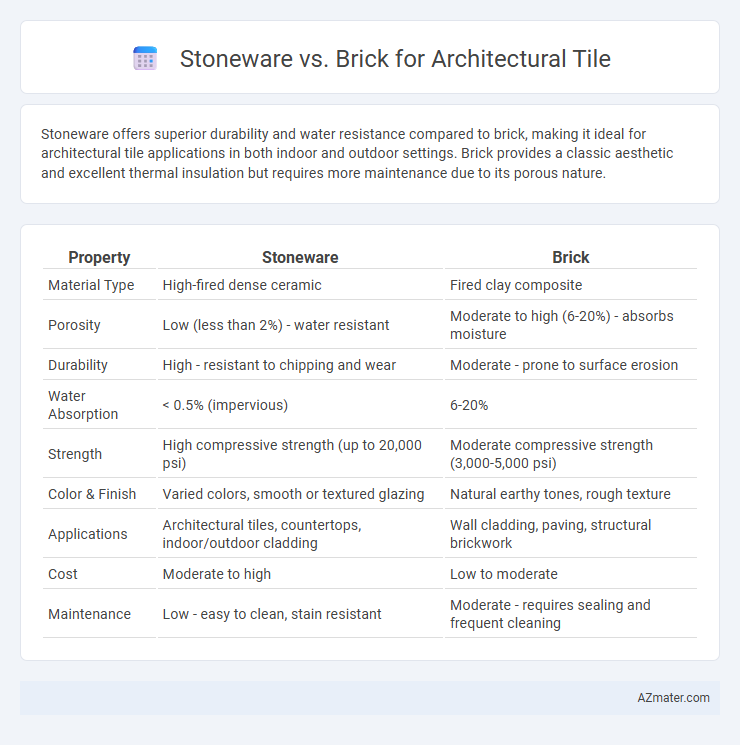Stoneware offers superior durability and water resistance compared to brick, making it ideal for architectural tile applications in both indoor and outdoor settings. Brick provides a classic aesthetic and excellent thermal insulation but requires more maintenance due to its porous nature.
Table of Comparison
| Property | Stoneware | Brick |
|---|---|---|
| Material Type | High-fired dense ceramic | Fired clay composite |
| Porosity | Low (less than 2%) - water resistant | Moderate to high (6-20%) - absorbs moisture |
| Durability | High - resistant to chipping and wear | Moderate - prone to surface erosion |
| Water Absorption | < 0.5% (impervious) | 6-20% |
| Strength | High compressive strength (up to 20,000 psi) | Moderate compressive strength (3,000-5,000 psi) |
| Color & Finish | Varied colors, smooth or textured glazing | Natural earthy tones, rough texture |
| Applications | Architectural tiles, countertops, indoor/outdoor cladding | Wall cladding, paving, structural brickwork |
| Cost | Moderate to high | Low to moderate |
| Maintenance | Low - easy to clean, stain resistant | Moderate - requires sealing and frequent cleaning |
Introduction to Stoneware and Brick
Stoneware exhibits dense, non-porous properties with high durability and resistance to water, making it an ideal choice for architectural tiles exposed to moisture and wear. Brick, composed primarily of fired clay, offers robust structural integrity and thermal insulation, favored for traditional and rustic architectural aesthetics. Both materials vary significantly in texture, porosity, and installation methods, impacting their suitability for specific architectural tile applications.
Historical Use in Architectural Tile
Stoneware and brick have both played pivotal roles in architectural tile applications throughout history, with stoneware prized for its durability and water-resistant properties, making it ideal for intricate facade and flooring designs in ancient civilizations. Bricks, often crafted from locally sourced clay, were extensively used in construction and decorative tile work due to their versatility and ease of mass production, particularly in Roman and Mesopotamian architecture. The enduring presence of stoneware tiles in historical sites underscores their importance in preserving ornamental and functional elements of architecture across centuries.
Material Composition and Properties
Stoneware architectural tiles are primarily composed of dense clay fired at high temperatures, resulting in a durable, non-porous surface resistant to moisture and abrasion. Brick tiles, made from natural clay with a coarser texture and lower firing temperatures than stoneware, offer a more porous and less dense structure, which affects their strength and water absorption. The material composition of stoneware provides enhanced durability and a smoother finish, while brick tiles exhibit greater breathability and rustic aesthetic qualities.
Durability and Weather Resistance
Stoneware tiles offer exceptional durability and superior resistance to weather conditions due to their dense, non-porous composition, making them ideal for exterior architectural applications. Brick tiles, while robust and capable of withstanding harsh climates, are generally more porous and can absorb moisture, increasing susceptibility to freeze-thaw damage over time. Selecting stoneware for architectural tile ensures long-term performance with lower maintenance in environments exposed to fluctuating temperatures and heavy precipitation.
Aesthetic Qualities and Color Options
Stoneware tiles offer a rustic, earthy aesthetic with natural textures and warm, muted color palettes including browns, grays, and terra cottas, ideal for creating organic and timeless spaces. Brick tiles provide a classic, industrial charm characterized by rich reds, burnt oranges, and deep browns, often featuring varied surface textures that add depth and visual interest. Both materials deliver durable finishes, but stoneware allows more versatility in smooth or matte glazes, while brick emphasizes rugged, textured surfaces enhancing architectural focal points.
Installation Methods and Techniques
Stoneware tiles require precise cutting tools such as wet saws and diamond blades for clean edges, with installation methods involving thin-set mortar and grout to ensure strong adhesion and durability. Brick tiles demand surface preparation including cleaning and leveling, followed by applying mortar or adhesive with a notched trowel, and tapping tiles into place for proper alignment and bonding. Both materials benefit from sealing post-installation to enhance moisture resistance and longevity in architectural tile applications.
Maintenance and Longevity
Stoneware tiles exhibit superior durability and low porosity, making them highly resistant to stains, scratches, and moisture, which significantly reduces maintenance requirements over time. Brick tiles, while aesthetically appealing with a rustic texture, are more porous and prone to chipping and efflorescence, necessitating regular sealing and careful upkeep to preserve their appearance. The longevity of stoneware typically surpasses brick in architectural applications, as it withstands harsh weather and heavy foot traffic without significant degradation.
Cost Comparison and Value
Stoneware tiles generally offer a lower cost per square foot compared to traditional brick tiles, making them a budget-friendly option for large-scale architectural projects. While brick tiles provide exceptional durability and a classic aesthetic, stoneware's versatility and ease of installation deliver higher value for contemporary design needs. Investing in stoneware yields cost savings in both material and labor without compromising on long-term performance and visual appeal.
Sustainability and Environmental Impact
Stoneware tiles offer superior sustainability due to their natural clay composition and lower energy consumption during firing compared to brick tiles, which require higher kiln temperatures releasing more CO2. The durability and low porosity of stoneware reduce the need for frequent replacements, minimizing waste and resource use over time. Brick tiles, while recyclable, often involve more intensive extraction and manufacturing processes, increasing their overall environmental footprint.
Best Applications for Stoneware vs Brick
Stoneware tiles excel in high-moisture environments due to their dense, non-porous composition, making them ideal for bathrooms, kitchens, and exterior facades requiring weather resistance. Brick tiles offer superior thermal insulation and rustic aesthetics, suited for interior feature walls, fireplaces, and outdoor landscaping where durability and traditional appeal are priorities. Selecting stoneware supports low-maintenance, hygienic surfaces, while brick enhances warmth and texture in architectural designs.

Infographic: Stoneware vs Brick for Architectural Tile
 azmater.com
azmater.com